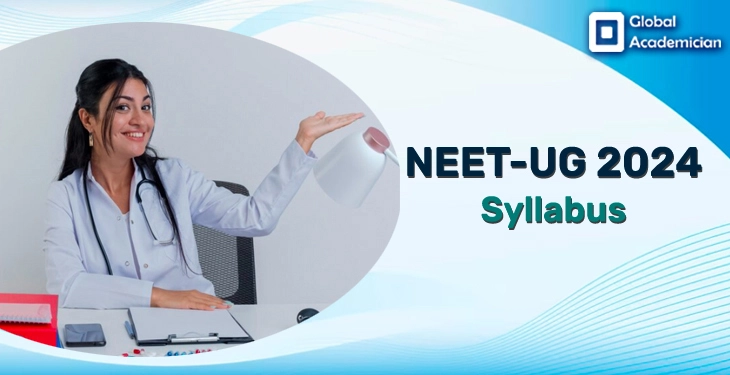
The National Medical Commission (NMC) has revised the NEET-UG 2024 syllabus in the official information bulletin published on February 9, 2024. NEET-UG (National Eligibility cum Entrance Test for Undergraduate) is an essential examination for students aspiring to pursue undergraduate medical and dental courses in India. A thorough understanding of the syllabus is crucial for effective exam preparation.
NEET-UG is an annual examination conducted by National Testing Agency. It serves as the gateway to prestigious medical and dental colleges across India. To sit for NEET-UG, candidates must meet specific eligibility criteria.
Crucial Changes for NEET UG 2024: Check Details
NEET-UG 2024 Syllabus:
Physics Chapters:
- Physics and Measurement
- Kinematics
- Laws of Motion
- Rotational Motion
- Gravitation
- Properties of Solids and Liquids
- Thermodynamics
- Oscillations and Waves
- Electrostatics
- Current Electricity
- Magnetic Effects of Current and Magnetism
- Electromagnetic Induction and Alternating Current
- Optics
- Dual Nature of Matter and Radiation
- Atoms and Nuclei
- Electronic Devices
- Kinetic Theory of Gases
Topic Revised in Physics Syllabus 2024:
Here is the list of topics added or removed in the Physics Chapters:
| Unit Modifications | Removed Topics | Topics Added |
| Physics and Measurement | Understanding the scope and impact of physics, including its relationship with technology and society. Introduction to measurement, emphasizing the need for accuracy and precision. | Fundamental concepts of differentiation and integration applied to motion description. Introduction to scalar and vector quantities, along with vector operations. |
| Kinematics | Concepts of motion differentiation and integration. | Vector representation of motion, including position, displacement, and vector operations. |
| Laws of Motion | Equilibrium principles and friction considerations. | Examination of momentum conservation and equilibrium of forces, with practical applications. |
| Rotational Motion | Conservation of momentum in rotational systems. | Analysis of centre of mass in uniform objects. |
| Gravitation | Discussion on the motion and energy aspects of satellites. | Study of satellite motion, including time period and energy considerations. |
| Properties of Solids and Liquids | Elastic properties and thermodynamic concepts. | Exploration of fluid dynamics, including pressure, Pascal’s law, and the effects of gravity. |
| Thermodynamics | Principles of heat engines and refrigeration systems. | Understanding the functioning of heat engines and refrigerators. |
| Oscillations and Waves | Description of oscillation behavior and resonance. | Qualitative examination of oscillation types and resonance phenomena. |
| Electrostatics | Analysis of charge distribution within conductors. | Examination of free and bound charges within conductors, including practical applications. |
| Current Electricity | Study of electric charge flow in conductive materials. | Introduction to resistors, potentiometers, and measurement techniques in circuits. |
| Magnetic Effects of Current and Magnetism | Understanding magnetic fields and their effects. | Discussion on magnetic properties and the impact of temperature. |
| Electromagnetic Induction and Alternating Current | Introduction to LC oscillations. | Examination of electromagnetic induction principles and qualitative treatment of LC oscillations. |
| Optics | Discussion on reflection, refraction, and scattering of light. | Exploration of optical instruments and phenomena, including human eye corrections and telescope functionality. |
| Dual Nature of Matter and Radiation | Overview of the Davisson-Germer experiment. | Examination of the dual nature of matter and radiation. |
| Atoms and Nuclei | Introduction to isotopes, isobars, and radioactivity. | Discussion on radioactivity types and decay laws. |
| Electronic Devices | Overview of energy bands in solids and transistor operation. | Examination of transistor characteristics and applications as amplifiers and switches. |
| Kinetic Theory of Gases | Introduction to RMS speed and Avogadro’s number. | Examination of gas molecular speeds and Avogadro’s constant. |
NEET-UG 2024 CORE Physics Syllabus PDF:
Chemistry Chapters:
- Some Basic Concepts of Chemistry
- Atomic Structure
- Chemical Thermodynamics
- Some p-Block Elements
- Organic Compounds Containing Nitrogen
- Polymers
- Chemistry in Everyday Life
- Chemical Bonding and Molecular Structure
- Redox Reactions and Electrochemistry
- Chemical Kinetics
- d and f Block Elements
- Purification and Characterization of Organic Compounds
- Hydrocarbons
- Organic Compounds Containing Halogens
- Principles Related to Practical Chemistry
Topic Revised in Chemistry Syllabus 2024:
Here is the list of topics added or removed in the Chemistry Chapters:
| Unit Modifications | Removed Topics | Topics Added |
| Some Basic Concepts of Chemistry | General Introduction: Important and scope of chemistry | |
| Atomic Structure | Atomic number, isotopes and isobars. Concept of shells and subshells, dual nature of light | Nature of electromagnetic radiation, photoelectric effect; Spectrum of the hydrogen atom. Bohr model of a hydrogen atom – its postulates, derivation of the relations for the energy of the electron and radii of the different orbits, limitations of Bohr’s model |
| Chemical Thermodynamics | Third law of thermodynamics- Brief introduction | Fundamentals of thermodynamics: System and surroundings, extensive and intensive properties’ state functions, types of processes |
| Some p-Block Elements | Atomic number, isotopes and isobars, Concept of shells and subshells, dual nature of matter and light | |
| Organic Compounds Containing Nitrogen | Cyanides and Isocyanides- will be mentioned at relevant places | |
| Polymers | Classification- Natural and synthetic, methods of polymerization (addition and condensation), copolymerization. Some important polymers: natural and synthetic like polyesters, bakelite; rubber, Biodegradable and non-biodegradable polymers. | |
| Chemistry in Everyday Life | Chemicals in medicines- analgesics, tranquillisers, antiseptics, disinfectants, antimicrobials, antifertility drugs, antibiotics, antacids, antihistamines. Chemicals in food- preservatives, artificial sweetening agents, elementary ideas of antioxidants. Cleansing agents- soaps and detergents, cleansing action | |
| Chemical Bonding and Molecular Structure | Kossel – Lewis approach to chemical bond formation, the concept of ionic and covalent bonds, Elementary idea of metallic bonding, Fajan’s rule | |
| Redox Reactions and Electrochemistry | Electrolytic and metallic conduction, conductance and their in electrolytic solutions, molar conductivities variation with concentration: Kohlrausch’s law and its applications. Electrochemical cells – Electrolytic and Galvanic cells, different types of electrodes, electrode potentials including standard electrode potential, half-cell and cell reactions, emf of a Galvanic Cell and its measurement: Nernst equation and its applications, Relationship between cell potential and Gibbs’ energy change: Dry cell and lead accumulator, Fuel cells | |
| Chemical Kinetics | Pressure, collision theory of bimolecular gaseous reactions (no derivation) | |
| d and f Block Elements | Transition Elements | |
| Purification and Characterization of Organic Compounds | Purification – Crystallisation. sublimation, distillation, differential extraction, chromatography – principles and their applications. Qualitative analysis – Detection of nitrogen, sulphur, phosphorus and halogens. Quantitative analysis (basic principles only) – Estimation of carbon. hydrogen. nitrogen. halogens. sulphur. phosphorus. Calculations of empirical formula and molecular formulae: Numerical problems in organic quantitative analysis | |
| Hydrocarbons | Classification of isomerism. IUPAC nomenclature, general methods of preparation, properties, and reactions | |
| Organic Compounds Containing Halogens | General methods of preparation, properties, and reactions; Nature of C-X bond: Mechanisms of substitution reactions. Uses; Environmental effects of chloroform, iodoform freons, and DDT | |
| Principles Related to Practical Chemistry | Detection of extra elements (Nitrogen, sulphur, halogens), in organic compounds; Detection of the following functional group, hydroxyl (alcoholic and phenolic), carbonyl (aldehyde and ketones) carboxyl, and amino groups in organic compounds. The chemistry involved in the preparation of the following: The chemistry involved in the titrimetric exercises – Acids. bases and the use of indicators. oxalic-acid vs KMnO4. Mohr’s salt vs KMnO4. Chemical principles involved in the qualitative salt analysis | |
| Chemical principles involved in the following experiments: 1. Enthalpy of solution of CuSO4. 2. Enthalpy of neutralisation of strong acid and strong base 3. Preparation of lyophilic and lyophobic sols. 4. Kinetic study of the reaction of iodide ions with hydrogen peroxide at room temperature. |
NEET-UG 2024 CORE Chemistry Syllabus PDF:
Biology Chapters:
- Diversity in Living World
- Structural Organization in Animals and Plants
- Plant Physiology
- Human Physiology
- Reproduction
- Biology and Human Welfare
- Ecology and Environment
- Cell Structure and Function
- Genetics and Evolution
- Biology and Human Welfare
Topic Revised in Biology Syllabus 2024:
Here is the list of topics added or removed in the Biology Chapters:
| Unit Modifications | Removed Topics | Topics Added |
| Diversity in Living World | Three domains of life, Tools for study of Taxonomy – Museums, Zoos, Herbaria, Botanical gardens, Angiosperms, Angiosperms classification up to class, characteristic features and examples | |
| Structural Organization in Animals and Plants | Morphology, anatomy and functions of different systems (digestive, circulatory, respiratory, nervous and reproductive) of an insect (cockroach). (Brief account only) | Family (malvaceae, Cruciferae, leguminoceae, compositae, graminae) Morphology, anatomy and functions of different systems (digestive, circulatory, respiratory, nervous and reproductive) of an insect (frog). (Brief account only) |
| Plant Physiology | Transport in plants: Movement of water, gases and nutrients; Cell to cell transport-Diffusion, facilitated diffusion, active transport; Plant – water relations – Imbibition, water potential, osmosis, plasmolysis; Long distance transport of water – Absorption, apoplast, symplast, transpiration pull, root pressure and guttation; Transpiration-Opening and closing of stomata; Uptake and translocation of mineral nutrients-Transport of food, phloem transport, Mass flow hypothesis; Diffusion of gases (brief mention) | |
| Mineral nutrition: Essential minerals, macro and micronutrients and their role; Deficiency symptoms; Mineral toxicity; Elementary idea of Hydroponics as a method to study mineral nutrition; Nitrogen metabolism-Nitrogen cycle, biological nitrogen fixation | ||
| Seed dormancy; Vernalisation; Photoperiodism | ||
| Human Physiology | Digestion and absorption; Alimentary canal and digestive glands; Role of digestive enzymes and gastrointestinal hormones; Peristalsis, digestion, absorption and assimilation of proteins, carbohydrates and fats; Caloric value of proteins, carbohydrates and fats; Egestion; Nutritional and digestive disorders – PEM, indigestion, constipation, vomiting, jaundice, diarrhea | |
| Reflex action; Sense organs; Elementary structure and function of eye and ear | ||
| Reproduction | Reproduction in organisms: Reproduction, a characteristic feature of all organisms for continuation of species; Modes of reproduction – Asexual and sexual; Asexual reproduction; Modes-Binary fission, sporulation, budding, gemmule, fragmentation; vegetative propagation in plants | |
| Biology and Human Welfare | Tobacco abuse, Improvement in food production; Plant breeding, tissue culture, single cell protein, Biofortification; Apiculture and Animal husbandry | |
| Ecology and Environment | Habitat and niche, Population and ecological adaptations, Nutrient cycling (carbon and phosphorous); Ecological succession; Ecological Services-Carbon fixation, pollination, oxygen release. | |
| Environmental issues: Air pollution and its control; Water pollution and its control; Agrochemicals and their effects; Solid waste management; Radioactive waste management; Greenhouse effect and global warning; Ozone depletion; Deforestation; Any three case studies as success stories addressing environmental issues. | ||
| Cell Structure and Function | Classification and nomenclature of enzymes | |
| Genetics and Evolution | Protein biosynthesis | |
| Biology and Human Welfare | Dengue, Chikungunya |
NEET-UG 2024 CORE Biology Syllabus PDF:
Mastering the NEET-UG 2024 syllabus is a crucial step toward realizing your aspirations in the field of medicine and dentistry. Initiate your preparations early and remain dedicated to your studies. For inquiries or assistance, please don’t hesitate to contact us.
To stay ahead and stay informed about the latest educational updates, trends, and insights, we invite you to subscribe to our newsletter and regularly explore our blog. You can also connect with us on our Facebook Page to join our educational community at Global Academician. Join us on these platforms and embark on a journey of continuous learning and knowledge sharing.
- About NEET-UG 2024
- NEET-UG 2024 Admit Card
- NEET-UG 2024 Eligibility Criteria
- NEET-UG 2024 Exam Centers
- NEET-UG 2024 Important Dates




